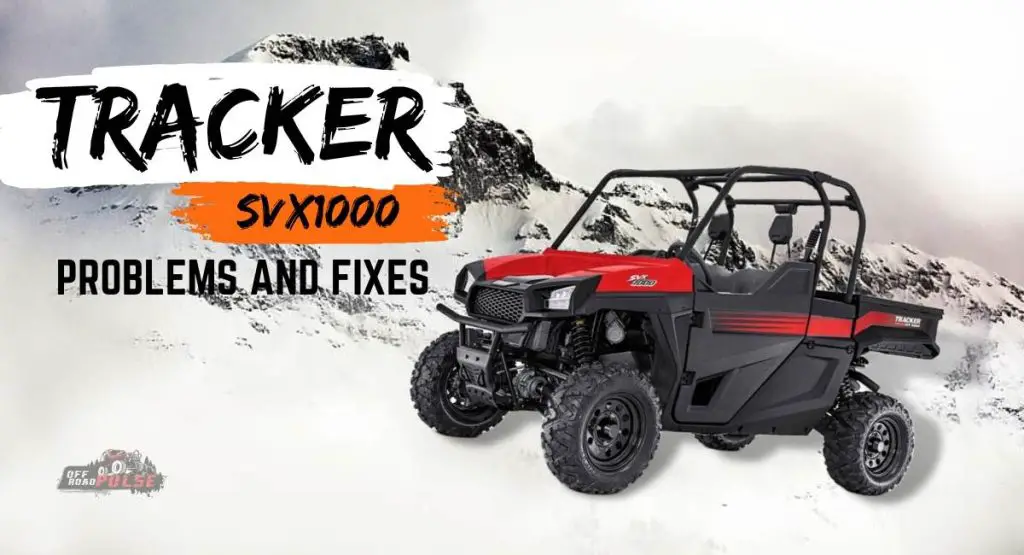The Tracker SVX1000 is a workhorse for any off-road enthusiast looking for something for cruising through untrodden woods. It is your ultimate companion for tackling the roughest terrains or hauling some stuff out. What’s most astonishing is how much Tracker SVX1000 packs at its price tag. Furthermore, this vehicle is easy to handle, making it one of the best UTVs for trail riding.
Unfortunately, the Tracker SVX1000 can experience a couple of problems that are likely to hold you back. Luckily, most of these issues can be avoided if the signs are addressed immediately. In this guide, we’ll discuss possible problems you’re likely to face with the Tracker SVX1000 and provide quick fixes.
Tracker SVX1000 Specs
| Engine | Displacement – 957cc Stroke – 4 Cooling – Liquid Fuel System – Electronic Fuel Injection (EFI) Horsepower – 100HP |
| Transmission | Transmission Type – CVT |
| Driveline | Types of Driveline – 2WD, 4WD Diff-lock – 4WD |
| Tires | Front – 27×9-14; Duro Powergrip Rear – 27×11-14; Duro Powergrip |
| Suspension | Front – Dual A-arm/12.8” travel Rear – Dual A-arm/12.9” travel |
| Dimensions | Length/Width/Height – 126”/64”/77” Fuel Capacity – 9.5 gal. Wheelbase – 85.2 inches Ground Clearance – 13 inches Towing capacity – 2000 lbs. |
Key highlights
- Tracker SVX1000 957cc liquid-cooled engine is designed to offer great power and performance on the roughest terrains.
- The dual A-arm suspension is designed to handle difficult obstacles.
- This vehicle comes with a CVT transmission for versatile gear ratios while allowing it to tow and haul heavy loads with ease. The design also includes an on-demand 4-wheel system to provide improved traction and stability on rough terrains.
- Lockable storage for secure transport of tools and equipment.
- Best in class 13 inches of ground clearance for improved off-road capabilities
- The Tracker SVX1000 includes 27-inch tires that provide a smooth ride and good traction
- Durable and rugged frame to withstand the toughest terrains and conditions.

Tracker SVX1000 Problems
1. Brake problems
Off-roading is inherently dangerous, and the brake system is often the first line of defense against unforeseen accidents. However, like any other mechanical component, brakes aren’t foolproof. Over time, the Tracker SVX1000 brakes may wear out or fail to function properly at some point.
Worn brake pads are by far the most common cause of brake problems. If the brake pads are worn, they might struggle to put enough friction on the wheels, which allows the vehicle to stop. This can also increase stopping distance and cause other mechanical issues.
Brake failure can be a terrifying experience, but luckily it is often easy to tell when a brake issue is beckoning. If you start to notice that your UTV brakes are producing unusual noises, make a point to take your vehicle to a repair shop to have them checked.
You will also need to pay close attention to how your brake pedal feels. If they feel somehow spongy than usual, it might be a sign of a potentially serious brake problem. That said, it is critical to maintain the brake system regularly and address any potential problem as soon as it appears.
2. Tracker SVX1000 starting problems
Like any other Tracker UTV, the SVX1000 may experience starting problems from time to time. In most cases, difficulty starting is often rooted within the ignition system, but it can also be caused by other reasons.
Some common causes of starting problems with the Tracker SVX1000 UTV include a dead battery, faulty starter, fuel system issues, damaged wiring, etc. If your battery is weak or running out of charge, your machine may not have enough power to start. To rule out a faulty battery, you can use a voltmeter to test its voltage.
On the other hand, the starter is responsible for igniting the engine, so if it is faulty, the vehicle will not start. The first sign of a malfunctioning starter is a clicking noise when turning the key. If your starter is faulty, then you’ll need to repair or replace it immediately.
You may also need to inspect the spark plugs and ignition coils for any signs of damage or cracking. Similarly, inspect the wiring connections, and if there is any part that needs to be repaired or replaced, it should be done by a professional mechanic.
If the engine is cranking but not starting, counter-check the compression and make sure that the fuel filter, air filter, and oil filter are clean and not clogged. In addition, check the fuel pressure and make sure the injectors are working properly.
3. Overheating engine
Engine overheating is a serious problem, and it can cause damage to your Tracker SVX1000 UTV if not addressed promptly. The engine can due to several reasons that might make it impossible for heat to leave the engine compartment. Some common causes of overheating engine problems include;
- Low coolant level – If the engine coolant level is running low, then it is likely to overheat due to inadequate coolant flow. This issue can be caused by a leak in the coolant system, or even a malfunctioning radiator.
- Clogged / faulty radiator – On the other hand, if the radiator is clogged with debris or oil smudges, it may not be able to dissipate heat properly, thereby causing the engine to overheat.
- Leaking/damaged head gasket – If the head gasket is leaking, it might create room for coolant to enter the combustion chamber. This might cause the engine to overheat.
- Faulty water pump – The engine is also likely to overheat if the water pump is not functioning properly. Ideally, a faulty water pump might interfere with the circulation of coolant, thereby putting our engine at risk.
Regardless of the source of the problem, engine overheating is not something you want to play around with. If overheating is not addressed appropriately, the engine could suffer serious, if not irreversible, damage.
Once your engine starts to overheat, pull over immediately and let it cool down for a couple of minutes. You’ll also need to check the coolant level, and if it’s low, immediate top-up might help prevent further engine damage until you get the problem fixed.
However, the best way to keep overheating in check is by having regular flushes performed on your UTV. You may also want to keep up with a routine radiator maintenance as stipulated in the user manual. Regular inspections can also help prevent overheating issues before they become worse.
4. Reduced speed
Speed issues are not considered a big problem by SVX1000 riders, but reduced speed can be a turnoff, especially when riding on open fields. There are several potential causes for reduced speed in this UTV, but the primary culprit is low engine power.
Reduced speed may also be caused by problems within the transmission, such as low fluid levels or worn gears. Other possible causes include low tire pressure, worn tires, and a problem with the suspension or air intake system.
The first step you can take to increase the Tracker SVX1000’s top speed is installing a performance chip. This will help to adjust the engine’s settings while allowing it to optimize power and increase top speed. You can also upgrade the air intake and switch to more powerful tires and see if they will help increase the top speed.
5. Unrestrained vibration
Excessive vibration in the Tracker SVX1000 can be caused by several reasons, including worn suspension parts, imbalanced wheels, or problems with the powertrain. However, in most cases, the vibration is caused by an issue with the balance or alignment of the tires.
To diagnose and fix the problem, you may want to get qualified personnel to inspect your UTV and possibly perform tests, such as road tests and wheel balancing. If the issue is found to be with a specific component, such as the tires or suspension, you’ll need to go for repairs or possible replacements.
If the issue is found to be with the powertrain, then further diagnosis may be necessary. Regardless of the problem source, it is important to address the issue as soon as possible since excessive vibration can lead to more serious problems and safety hazards.
6. Faulty exhaust
A clogged exhaust system on the Tracker SVX1000 can cause a variety of complications, such as reduced engine power and decreased top speed overall. A malfunctioning exhaust can also lead to increased emissions and excessive noise, which are not only harmful to the environment but might also, be illegal in some states.
On top of that, faulty exhaust systems can reduce fuel efficiency, leading to increased fuel costs. Now, to troubleshoot exhaust system issues, you can start by inspecting the entire system for any visible signs of leaks. If you find a leak, it will likely need to be repaired or replace the damaged part.
The exhaust pipe or muffler might clog, and this can make the machine run poorly or stall. To clear a clogged exhaust pipe, you can use compressed air or a pipe cleaner to get rid of any debris. You’ll also need to check the exhaust for any visible signs of damage, such as holes or rust. If the exhaust is severely damaged, consider getting a replacement.
Parting Shot!
The Tracker SVX100 is a great choice for those who need a reliable and durable off-road vehicle that can handle challenging terrain and heavy loads. But while it is made to withstand tough off-road conditions, it is still prone to issues due to the high-stress state it is constantly under. However, with proper knowledge and care, this UTV can be an incredible choice for anyone looking for an adventure-ready machine.




